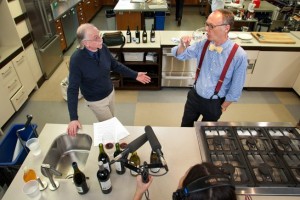
Let’s talk about wine bubbles. Not bubbles as in Champagne, but the kind of bubbles that are created when a market overheats. Think real estate, for example, the stock market, or, even tulips.
In a wine bubble, a particular kind or category of wine becomes wildly popular—far too popular for its own good. To meet the crazy new demand for it, enormous amounts of wine must be produced, the greatest share of which will necessarily be of indifferent quality or even worse. The result is that the category is gradually debased, its reputation tanks, and even good examples suffer by association.
Examples of this abound, but if you’re of a certain age, you can probably name a few of these destructive cycles. Lambrusco, Soave, Bardolino, Chianti, pink wines—all existed in more or less respectable form until some clever chap came along and turned what had been an authentic local wine into an ersatz beverage aimed at a mass market. In some cases we’re still dealing with the fallout from the bubbles that were created around these wines. I still have to work pretty hard to explain to people how a beautifully-made, traditional rosé from a family estate in the south of France is not Sutter Home White Zinfandel.
Something like this happened with Chardonnay in the last 20 years or so. In this case the bubble wasn’t just around a grape varietal but a style of wine: warm climate chardonnay with tropical fruit flavors sauced with oak and butter.
Cheap versions of this were truly dreadful things, and the backlash has been such that for some people chardonnay of any stripe has become kitsch wine. And once people come to think of a wine as kitsch (cheesy; tacky) they don’t want to be seen drinking it. I often encounter folks who simply refuse to drink chardonnay—even in its most authentic and delicious forms— because they feel the wine is kitsch.
We did a bit a year or two ago on a Test Kitchen radio segment to rehabilitate Chardonnay, explain the variety of expressions it is capable of, and taste some really fine examples.
In our radio segment this week, my goal was to try to do the same for merlot, another category of wine that had its bubble stage and then pretty much collapsed into something called “The Sideways Effect,” which I’ll explain in a moment.
To provide Chris with models for how appealing and downright delicious merlot can be, I chose three wines from the Formaggio Kitchen shelves for him to taste. These were the 2009 Paraschos Friuli-Venezia-Giulia Merlot, the 2006 Caparone Santa Maria Valley Merlot, and the 2011 Jarnicoton Buzet from Domaine du Pech. Although merlot is often used as a blending grape, each of the three Chris tasted are composed solely of this varietal. There’s no hint of kitsch about them. On the contrary, each is an authentic wine from a region that has a long history with it.
In the case of the Great Merlot Bubble, the phenomenon might be said to have been foreseeable given the grape’s propensity when grown in warm, sunny climes to develop big fruit and ingratiatingly soft tannins. As occasional and new-to-wine American drinkers flocked to it, large swaths of vineyard acres in California were replanted to meet the demand. The whole lovely mania was rolling along at a fine clip when it hit a nasty bump in the road.
I’m talking about the 2004 film “Sideways” in which a couple of pals head to wine country for a last fling week before one of them is married. One of the pair, sad sack, love-lorn Miles, is a wine snob: thinks pinot noir is just about the only thing worth drinking and has nothing but contempt for merlot. When a distraught Miles shouts at a bartender “I’m not drinking any [expletive] merlot!” you could almost hear the bubble pop. Sales of merlot fell dramatically, and a new trend began to grow up around—you guessed it—pinot noir.
The thing about wine bubbles that’s important to remember is this: even at the height of the hysteria, there will be those properties where the integrity is such that they’ll not be compromised by something as silly as a bubble.
Your part in this is to have the sense not to condemn an entire category for the sins of some and to remain loyal to the best examples of the breed while rejecting kitsch. As always, your ally in the noble struggle to keep your head while all about you are losing theirs will be that local wine shop where the staff is both knowledgeable and passionate about wine.
If you heard the segment, you know that Chris was wildly enthusiastic about the wines he tasted. He made it clear that this was a category of wine he’ll be seeking out more of. Go, thou, and do likewise.
Stephen Meuse can be reached at stephenmeuse@icloud.com